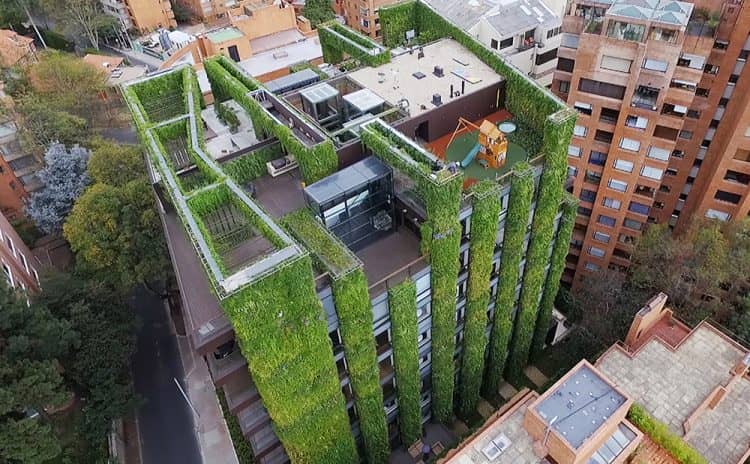As the industrial revolution brought luxury in our lives, it also brought pollution to our environment. Many are making efforts to make the planet greener, supporting a transition to clean sustainable energy sources. Vertical garden buildings are a part of that effort in the Urban Skylines. Bosco Verticale by Stefano Boeri in Milan was the first greenery covered building in the world and trend caught on. With a twisted garden building in France and China’s vertical forests, another one stands in Columbia.
In the heart of Bogota, Columbia stands the world’s largest vertical garden building Edificio Santalaia, completely covered in a luscious layer of 115,000 plants spanning over 3,100 square meters (33,368 square feet). The 11 story building is considered one of the most spectacular urban gardens ever. The Spanish green designers Paisajismo Urbano and the Colombian company Groncol partnered for the project that was completed in December 2015. The building is referred as “the green heart of Bogota” representing sustainability, reminding us every day how crucial the plants are to our lives.
The 10 different species and 5 families of plants were selected by the head of Paisajismo Urbano, Ignacio Solano and his team from the Columbian Choco forest. The important concern was the interaction of plants with each other and achieving a uniform covering on the building. Solano explained the matter saying, “The selection of the species is fundamental in this type of gardens since the biodiversity in a vertical ecosystem allows the interaction between the species that form it, both plants and microorganisms. The large surface area involved was an additional difficulty compared to other vertical gardens since it involved the use of a greater number of plants.”
The biggest challenge in the design of such a building is creating an efficient irrigation system. It would have been simpler had the plants been chosen from the same species or at least the same family, but the diverse range makes the water and nutrient control more complex. The designers developed a special irrigation system, patented by Ignacio Solano that uses 40 irrigation sectors that are regulated automatically depending on humidity and solar radiation. The leftover water is recycled through the living walls along with the waste water of its residents.
According to the Paisajismo Urbano website, “A vertical garden of this size is capable of producing the oxygen needed by more than 3,100 people a year, processing about 775 kilograms of heavy metals, filtering more than 2,000 tons of harmful gasses and catching more than 400 kilograms of dust.”
The building is not just a sign of beauty, it serves a far greater purpose, accommodating for the carbon footprint of 700 people. The green carpet also serves as natural insulation, reducing the use of air conditioners during hot summer months.
It may be hard to design but is certainly not hard to imagine entire city skylines made up of buildings carpeted with greenery. We might actually be able to fix a lot of damage that we have caused to our planet.

